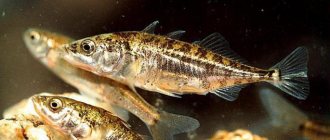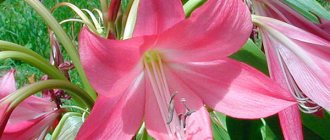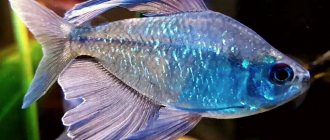- Wild animals
- >>
- Crustaceans
Daphnia is a small crayfish that lives mostly in fresh water bodies of the planet. Given their miniature size, they have a rather complex structure and serve as an important element of the ecosystem - by multiplying quickly, they allow fish and amphibians to feed, so that without them, reservoirs would be much emptier. They also feed the fish in the aquarium.
Origin of the species and description
Photo: Daphnia
The genus Daphnia was described in 1785 by O.F. Muller. There are about 50 species of Daphnia, and many of them have significant differences from others. Daphnia longispina, described by the same Müller, is used as the type species.
Daphnia is divided into two large subgenera - Daphnia proper and Ctenodaphnia. The latter differ in a number of characteristics, for example, the presence of a notch in the head shield, and in general have a more primitive structure. But this does not mean that they occurred earlier: fossils date the origin of both to approximately the same time.
Video: Daphnia
The first representatives of branchiopods appeared about 550 million years ago, among them were the ancestors of daphnia. But they themselves arose much later: the oldest fossil remains date back to the Lower Jurassic period - that is, they are approximately 180-200 million years old.
These are not as ancient times as one might expect from relatively simple organisms - for example, fish and birds appeared much earlier. But, like other representatives of the superorder Cladocera, even in those days daphnia were similar to those of today, and in this they differ from more highly organized organisms of the same antiquity.
At the same time, one should not think that daphnia do not evolve: on the contrary, they have high evolutionary variability and adaptability, and constantly give rise to new species. The final formation of the Daphnia genus occurred immediately after the extinction at the end of the Cretaceous period.
Seagulls
Seabirds have long served as living sensors. For example, herring gulls Larus argentatus
Since the 1970s, they have been helping environmentalists and toxicologists track information about environmental pollutants in the North American Great Lakes region.
The researchers do not catch the birds themselves, they are interested in the eggs of herring gulls - as well as the eggs of thick-billed guillemots Uria lomvia
, fulmars
Fulmarus glacialis
, kittiwakes
Rissa tridactyla
, glaucous gulls
Larus hyperboreus
and guillemots
Cepphus grylle
. All these birds, as a rule, nest in Arctic and subarctic regions. Typically, birds that nest in isolated colonies accessible to humans are chosen for the role of living sensors, so that it is easy to take “samples” and compare the results for representatives of the same species living in different parts of the globe.
One of the main results of monitoring the concentrations of the most common environmental pollutants, such as DDT, polychlorinated biphenyls and dioxins, was a series of bans on the use of some of them in the 1970s and 1980s and serious restrictions on the use of others. A study of the “chemistry” in bird eggs showed that from 1975 to 2003, birds were exposed to significant amounts of brominated flame retardants, and since 2003, after other fire retardants were introduced, the content of organobromines has decreased sharply. The content of long-chain fluoroalkyl derivatives in the body of birds and their eggs increased from 1975 to 2009, and after a mutual agreement between chemical companies to limit their use, it began to decrease. As for the mercury content in seabird eggs, it increased from 1975 to 1993, after which it plateaued and stopped changing.
Appearance and features
Photo: Daphnia moina
Daphnia species can vary greatly: the shape of their body, as well as its size, is determined by the conditions of the environment in which they live. However, some common features can be identified. Thus, their body is covered with a chitinous shell with transparent valves - the internal organs are clearly visible. Due to the transparency of water, daphnia are less noticeable.
The shell does not cover the head. It has two eyes, although often as they grow they merge into one compound eye, and sometimes daphnia has a third, but usually it stands out clearly and is smaller in size. There are antennae on the sides; daphnia constantly waves them, and with their help they move by jumping.
On the head, the rostrum is a beak-like outgrowth, and under it there are two pairs of antennae, the rear ones being larger and having bristles, due to which their area increases. With the help of swinging these antennas, movement is carried out - when stroked by them, daphnia flies sharply forward, as if making a jump. These antennae are well developed and have strong muscles.
The body is flattened laterally, the legs are flattened and underdeveloped, because they are not used for movement. Mainly used to push fresh water to the gills and food particles to the mouth. The digestive system is quite complex for such a small crustacean: there is a full-fledged esophagus, stomach and intestines, in which the liver outgrowths are located.
Daphnia also has a heart that contracts at a high speed - 230-290 beats per minute, resulting in blood pressure of 2-4 atmospheres. Daphnia breathe throughout the body, but primarily with the help of respiratory appendages on the limbs.
Where does daphnia live?
Photo: Daphnia magna
Representatives of the genus can be found almost throughout the Earth. They were even discovered in Antarctica in samples taken from relict subglacial lakes. This means that daphnia are capable of living in almost any natural environment present on our planet.
However, if a century ago it was believed that all their species were distributed everywhere, then it was found that each of them has its own range. In many species they are quite wide and include several continents, but still there is not one that is widespread everywhere.
They inhabit the Earth unevenly, preferring weather conditions in the subtropics and temperate zones. There are noticeably fewer of them both at the poles of the planet and near the equator, in a tropical climate. The ranges of some species have undergone significant changes very recently due to their spread by humans.
For example, the species Daphnia ambigua came from America to Great Britain and successfully took root. On the contrary, the species Daphnia lumholtzi was brought to North America from Europe and became common in the water bodies of this continent.
Water bodies without current, such as ponds or lakes, are preferred for daphnia habitat. They often live in large puddles. There are far fewer of them in slow-flowing rivers, and they are almost never found in fast-flowing rivers. Most species live in fresh water.
But the ability to adapt was also evident here: daphnia, which once found themselves in arid conditions, where only salty bodies of water were available to them, did not die, but developed resistance. Now the species descended from them are characterized by a preference for water bodies with a high salt content.
They live best in clean water - it should contain as little groundwater as possible. After all, daphnia feed by filtering water and, if it is dirty, soil particles get into their stomach along with microorganisms, which means that in polluted water bodies they die much faster due to clogging of the stomach.
Therefore, by the number of daphnia in a reservoir, one can judge how clean the water is. They live mainly in the water column, and some species even live at the bottom. They do not like bright lighting and go deeper when the sun begins to shine directly on the water.
Mussels
In the late 1960s, it was determined that chlorine-containing pesticides, mercury-containing compounds, and petroleum products had become a serious threat to the inhabitants of coastal marine and ocean waters. Various species have been tried to assess the status of these waters, including lobsters, crabs and fish; however, the varied behavior and diet of disparate species cast doubt on the reproducibility of the results and the validity of their comparison. In 1975, marine geochemist Edward Goldberg proposed a simple solution: use mussels ( Mussel Watch
). This program was the first step in biological monitoring of coastal water pollution.
Mussels, a cosmopolitan species that can thrive in both fresh and salt waters, along with oysters and other edible shellfish, are ideal for this task. They are found everywhere and are easy to collect. In addition, mussels and oysters are often grown specifically for the food industry, which further facilitates population monitoring and testing. Mussels feed on phytoplankton and, in order to filter it, pass large amounts of water through themselves. Like many other animals, mussels have not evolved the ability to produce enzymes that break down pollutants like PCBs and hydrocarbons, so they concentrate these substances in their bodies, making analysis easier. More than four decades later, a local program in the United States to determine toxic substances using mussels has become international, and thanks to it, they monitor not only the presence of foreign substances in coastal waters, but also the degree of their harm to humans.
What does daphnia eat?
Photo: Daphnia in the aquarium
In their diet:
- ciliates;
- seaweed;
- bacteria;
- detritus;
- other microorganisms floating in water or lying on the bottom.
They feed by filtering water, for which they move their legs, causing it to flow. Filtration of the incoming water flow is carried out by special fans on filter bristles. The absorbed particles are then clumped together due to secretion processing and sent to the digestive system.
Daphnia is notable for its gluttony: in just one day, some species eat 6 times their own weight. Therefore, when the amount of food decreases, there are fewer of them in the reservoir - this happens with the onset of cold weather, but the largest number of daphnia appears in late spring and summer.
Those species of daphnia that do not hibernate in winter feed on detritus. They spend the winter at the bottom of the reservoir and in layers of water close to it - the food there is dominated by detritus, that is, particles of tissue or secretions of other living organisms.
They themselves are used as food for fish in an aquarium - they are very useful due to the fact that their stomachs contain a lot of plant food. Daphnia are either given dry or released alive into the aquarium. The latter is also useful if the water in it becomes cloudy: daphnia eat the bacteria that cause this to happen, and fish, in turn, eat daphnia.
Conditions for breeding
Many people breed daphnia at home, which is quite simple. However, this process must be given due attention. The color of the water in the container plays a big role. It should be greenish or light brown.
Don't forget to add yeast to your diet
It is impossible to allow other representatives of water bodies, for example, cyclops, to get into the container with daphnia. At home, the diet of crustaceans should consist of dry lettuce leaves or grapes. Baker's yeast is added to the diet. They are ground to a powder and then strained through cheesecloth. To get them at home, you need to take water with 50 crustaceans from a natural reservoir with prepared food and only then put them into the prepared vessel.
Features of character and lifestyle
Photo: Daphnia crustaceans
They are mainly found in the water column, moving by jumping, sometimes crawling along the bottom of the reservoir or the walls of the aquarium. They often move depending on the time of day: when it is light, they dive deeper into the water, and at night they find themselves at the very edge.
A lot of energy is spent on these movements, so they must have a reason. However, it has not yet been possible to find out exactly. There are several most likely assumptions. For example, that large daphnia are forced to sink deeper during the day in order to become less noticeable to predators - after all, the deep layers of water are less well lit.
This assumption is confirmed by the fact that in reservoirs in which there are no fish feeding on daphnia, this kind of migration occurs much less frequently. There is a simpler explanation - that daphnia simply strive for that layer of water where the temperature and illumination are optimal for them, and during the day it moves up and down.
Their lifespan varies greatly from species to species. Usually the pattern is simple - the largest ones live longer. Small daphnia are given 20-30 days, the largest ones up to 130-150 days.
Interesting fact: It is customary to test the toxicity level of various solutions on daphnia. They react even to small concentrations - for example, they can become slower or sink to the bottom.
Social structure and reproduction
Photo: Daphnia
Daphnia are very prolific, and their reproduction is interesting in two stages - they reproduce both asexually and sexually. In the first case, only females are involved and parthenogenesis is used. That is, they reproduce themselves without fertilization, and their offspring receive the same genotype as that of the single parent. It is thanks to parthenogenesis that when good conditions arise, their number in the reservoir increases significantly in the shortest possible time: usually this method of reproduction in daphnia is used in late spring and summer, when there is most food for them.
Reproduction in this case proceeds as follows: eggs are laid in a special cavity and develop without fertilization. After their development ends and a brood of new daphnia appears, the female molts, and after just 3-6 days she can begin a new cycle. By that time, the females that appeared last time are also ready to reproduce.
Considering that dozens of new daphnia appear in each brood, their numbers in the reservoir grow at a very rapid pace, and in just a couple of weeks it can be filled - this becomes noticeable by the reddish tint of the water. If there is a shortage of food, males appear in the population: they are smaller and faster than females, and they also stand out for some other structural features. They fertilize the females, as a result of which eggs appear in the so-called ephippia - a durable chitinous shell that allows them to survive unfavorable conditions.
For example, they do not mind cold or drying out of the reservoir; they can be carried by the wind along with dust, and do not die when passing through the digestive system of animals. They don’t even mind being in solutions of toxic salts, their shell is so reliable.
But, while reproduction by parthenogenesis is simple for daphnia, bisexual reproduction requires much more effort, and in many species the females even die after laying eggs. After entering favorable conditions, the next generation of daphnia hatches from the eggs and reproduces again by parthenogenesis. Moreover, only females appear, since males do not survive unfavorable conditions.
Now you know how to breed daphnia. Let's see what dangers await daphnia in the wild.
Bees
Honey bees Apis mellifera
can be considered nature's most underrated heroes. While flying about their business, collecting pollen and nectar, they also pollinate plants. It is difficult to call the bees themselves a species suitable for use as living indicators - bees are cultivated, beekeepers take care of them, often, as various honey plants bloom, they move bee colonies from one area to another, after which it can be difficult to link data on pollutants to which -a certain area. However, these insects also contribute to the study of the state of the environment - honey is analyzed for this.
Massive use of insecticides in agriculture is a serious threat to bees and other pollinators. For example, the main suspects in the case of a sudden decline in bee numbers are neonicotinoid insecticides, which can attack the nervous system of these insects. They affect the learning ability of bees, their ability to recognize odors and orient themselves in space. All this interferes with food collection, reduces the number and number of bee colonies, which in the long term can reduce agricultural yields and cause a food crisis. Recently, researchers have even begun to use microsensors that are attached to the backs of bees to track the movements of individual insects from hives to honey plants and determine their ability to pollinate plants.
A study published this year of 200 honey samples from around the world found that 75% of samples contained at least one of the five major neonicotinoids, and 45% had two or more. Concentrations of pesticides in honey are well below the limit set by U.S. and EU regulators as safe for humans, but a third of the samples had enough neonicotinoids to harm bee larvae ( Science
, 2021, 358, 6359, 109–111).
So, we can say that the environment itself comes to the aid of Homo sapiens, who wants to preserve this environment - plants, fungi, invertebrates and vertebrates sacrifice themselves to tell how expensive technologies that make life easier for people cost nature. And if we carefully monitor our “canaries,” we may have time to escape.
Natural enemies of daphnia
Photo: Daphnia eggs
Such small and defenseless creatures have many enemies - predators that feed on them.
This:
- small fish;
- fry;
- snails;
- frogs;
- larvae of newts and other amphibians;
- other predatory inhabitants of water bodies.
Large and even medium-sized fish are practically not interested in daphnia - for them it is too small prey, which requires too much to saturate. But small things are another matter; for small fish, if there are a lot of daphnia in the reservoir, they serve as one of the main sources of food.
This is especially true for large species, because for small daphnia their very size serves as protection - even a small fish will not chase a crustacean half a millimeter in size, but large specimens 3-5 mm in size are another matter. It is fish that are the main predator that destroys daphnia, and larger fish fry also feed on them. Daphnia is also one of the main sources of food for them.
But even if there are no fish in the reservoir, they are still threatened by many dangers: large individuals are eaten by frogs and other amphibians, and their larvae eat small ones too. Snails and other predatory mollusks feed on daphnia - although daphnia may try to “jump” from some of them, unlike much more agile fish.
Interesting fact: Decoding the Daphnia genome has revealed a lot of interesting things to scientists: approximately 35% of the gene products found in the genome are unique, and are very sensitive to any change in the environment. It is due to this that daphnia adapt so quickly.
Lichens
Lichens are symbiotic associations of fungi and microscopic green algae or cyanobacteria. There are known types of lichens of various sizes and colors. Some of them resemble miniature plants, others resemble paint stains on rocks and tree trunks. Lichens do not have a root system; they absorb nutrients directly from fog, rain and whatever the wind brings them. Consequently, they have no barriers to protect against hazardous substances, and when environmental pollution increases, they are the first to die. Lichens, of course, are pitiful, but this property makes them good living sensors.
Lichens have been used in this capacity since the 1860s, when botanists in Paris discovered that lichens grow in areas with clean air, and where the air is dirty, their colonies begin to feel worse. Initial studies were mainly devoted to the direct effect of sulfur dioxide released during the combustion of coal on lichens. After some time, it turned out that lichens also make it possible to track the effects of acid rain - if the emissions of an enterprise contain sulfur dioxide or nitrogen dioxide, they dissolve in raindrops, forming acids. In addition, these organisms can serve as indicators for nitrates and ammonium ions, the main source of which is agriculture. Metals from zinc to mercury also accumulate in lichens.
In the 1980s, the US Federal Forestry Agency launched a biomonitoring program that records data on the diversity and distribution of lichens in all regions of the country. The condition of lichen colonies is recorded, samples are collected and analyzed in laboratories to determine the degree of air pollution in certain areas, identify their causes and, if necessary, adjust industrial emission standards.











